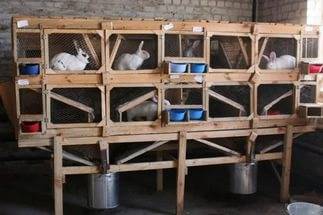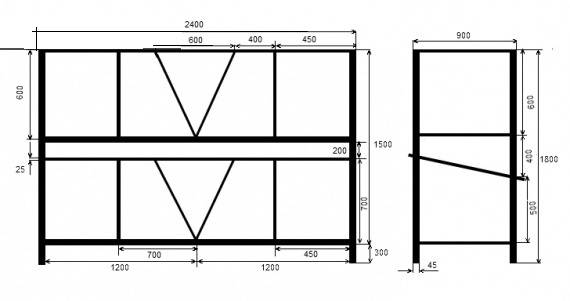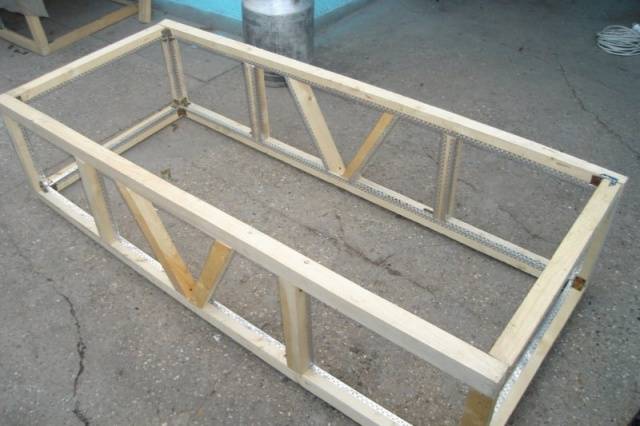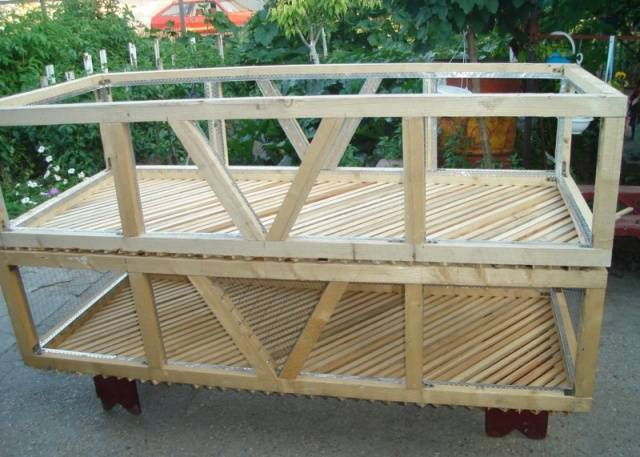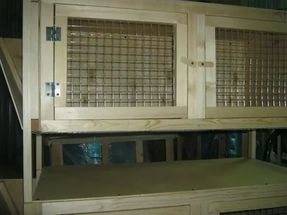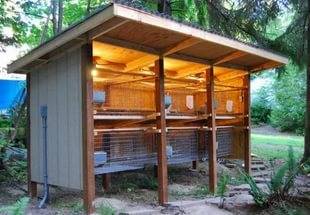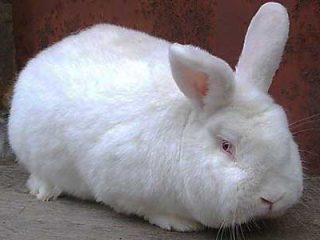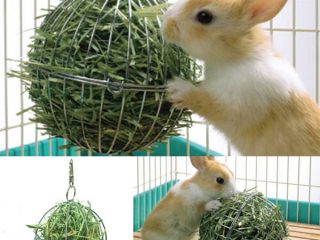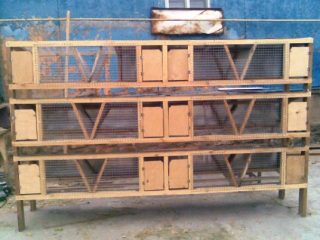Content
Most novice rabbit breeders keep long-eared pets in single-tier cages. However, such housing is enough for a small number of livestock. Animals multiply quickly and need to be resettled somewhere. There is only one way out. The number of cells needs to be increased. If you put them in one row, you will need a larger area. In this situation, a home-made two-tier rabbit cage will help out.
Design features and drawing of a two-tier cage
Standard two-tier cages for rabbits are structures 1.5 m wide and 1.8 to 2.2 m high. The structure is divided into sections. The capacity of the animals depends on their number. Usually 2–4 adult individuals live in such a house. As for the dimensions of the section itself, its width is 50 cm, and its height and depth are 60 cm.
The sections are separated by a V-shaped hay barn. The width of its upper part is 20 cm. Each compartment is equipped with a feeder, which takes up about 10 cm of free space.
In the video Zolotukhin N.I.talks about the design of his cells:
When developing a cage drawing, you need to provide a system for removing manure. To do this, a gap is left between the first and second tier. This is where the tray will be inserted. It is made at a slope towards the rear of the structure so that the manure does not fall under the feet of the rabbit breeder.
If a cage will contain a female rabbit with offspring, you need to take care of the queen cell. The floor in this compartment is made of solid boards. You need to immediately decide where the drinking bowls and feeders will be located, and decide on the design of the partitions. There are options when, instead of a hay box, an opening partition is installed inside the cage for the convenience of mating of opposite-sex individuals.
The design of the cage depends on the location of its installation. In the barn, the house is sheathed with mesh, and on the street they make solid walls, and they are also insulated for the winter. If free space allows, then you can build a run for young animals. A mesh enclosure is attached to the back of the main house.
The photo shows a diagram of a two-tier structure. The cage can be made according to the specified dimensions or you can make your own calculations. In general, the dimensions of housing for rabbits depend on their breed.
Choosing a place to install a two-story cage
The requirements for choosing a location for installing rabbit cages are the same regardless of their design. On the street, a two-story structure with an aviary is installed where there are no drafts. A slightly shaded area under trees is ideal. Rabbits will be able to walk all day without being overheated by the sun.
It’s a good idea to place a two-story structure near the wall of any building. It would be even better if there was a canopy on top. An additional roof will protect the house from precipitation and scorching sun rays.
When installing cages indoors, care must be taken to remove manure. If it accumulates a lot, animals will inhale the harmful gases released, which will lead to their death. In addition, the barn must be equipped with ventilation, but without drafts.
The video shows a cage for 40 rabbits:
DIY Bunk Cage Guide
Now we will try to consider in detail how to make a two-story home for long-eared pets yourself. For those who have already built single-tier cages, it will not be difficult to make such a structure. The technology remains unchanged, just adding another upper tier. Although, there are several nuances and they are related to the assembly of the frame, as well as the installation of a pallet between floors.
Frame assembly
The framework is the skeleton of the cell. It is a rectangular structure assembled from frames and fastened with vertical posts. The structure is assembled from timber with a cross section of 50x50 mm. The photo shows a version of a single-tier frame DIY rabbit cages, where the compartments will be separated by a V-shaped hay barn. For a two-story house, two such structures are assembled.
Corner posts are made solid, that is, common. Intermediate racks separating the compartments are installed for each tier. This is due to the fact that there is about 15 cm of free space between the first and second floors. A pallet will be installed here in the future.You can abandon the solid corner posts and assemble two separate frames. They are placed on top of each other, but legs are provided on the upper structure to create a gap for the pallet.
The frame of a two-tier cage for rabbits should be durable. It will support all the elements of the rabbit house: roof, walls, floor, feeders and drinking bowls with contents. Plus to this you need to add the weight of the pallets with accumulated manure and the weight of the animals themselves. Rabbits sometimes become too active. To prevent the frame from becoming loose during walking or foreplay of the animals, the joints of the wooden elements are reinforced with metal mounting plates.
Making floors, installing walls and interior fittings
When the frame is ready, proceed to laying the floor. For these works, it is optimal to use a wooden lath. It is nailed across the frame to the rear and front beams of the lower frame. If desired, you can nail the rail obliquely, as shown in the photo. There is no significant difference in the position of the slats, the main thing is that there is a gap between them. Through it, manure will fall onto the pallet.
When the flooring is completed, the legs are attached to the bottom of the frame made of timber with a cross-section of 100x100 mm. On the lower tier, it is better to make them 40 cm long. At this height from the ground, it is convenient to take the rabbit cage for transportation to another place. If the frame of the second tier was built as a separate structure, legs are also attached to the frame from below. Their length is selected so that there is a gap of 15 cm between the ceiling of the lower and the floor of the upper cage.
The material for wall cladding is selected taking into account the location of the cages. If they will be standing indoors, then a galvanized mesh is stapled to the frame.It is important to ensure that there are no protruding wires in the places where the mesh is cut. Otherwise, the rabbits may get hurt on them.
When installing cages outdoors, only the front part is sheathed with mesh. The side and back walls are made of solid plywood or boards. In regions with harsh winters, additional insulation is placed in the sheathing. In this case, double walls are made.
At this stage, you still need to install partitions. The V-shaped sennik is lined with coarse mesh or a lattice is made of steel rods. If the cages will contain individuals for mating, then a round or rectangular hole measuring 20x20 cm is cut in the partition and equipped with a shutter.
It is especially important to approach the arrangement of the queen cell correctly. Baby rabbits often roll out of the nest. If the baby falls from the second tier of the cage to the ground, he will be injured. To prevent this from happening, the lower part of the mesh walls in the queen cell is covered with boards, plywood or strips of flat slate. They do the same with the floor.
Installation of doors and roof
To make doors, rectangular frames are assembled from timber. They are attached to the frame with hinges. There are two opening positions for the sash: to the side and down. Here, each rabbit breeder chooses an option at his own discretion. The fixed frames are sheathed with mesh, and a latch, latch or hook is placed on the side opposite the hinges.
The roof structure depends on the location of the cage. When located outdoors, both tiers are covered with a solid ceiling made of boards or plywood. Beams are attached to the ceiling of the upper tier so that there is an overhang at the back and front. It will close the cells from precipitation. A sheathing is nailed onto the beams from boards, and a waterproof roofing covering, for example, slate, is already attached to it.
If a two-tier cage is installed inside, then the ceilings can be sheathed with mesh. The upper tier is covered with any light material. Such a roof will better protect the cage from dust settling.
The video shows a homemade cage for rabbits:
When the two-story house for rabbits is ready, a galvanized sheet steel pallet is installed between the first and second tier. Now you can install drinking bowls, feeders and let the animals run.
